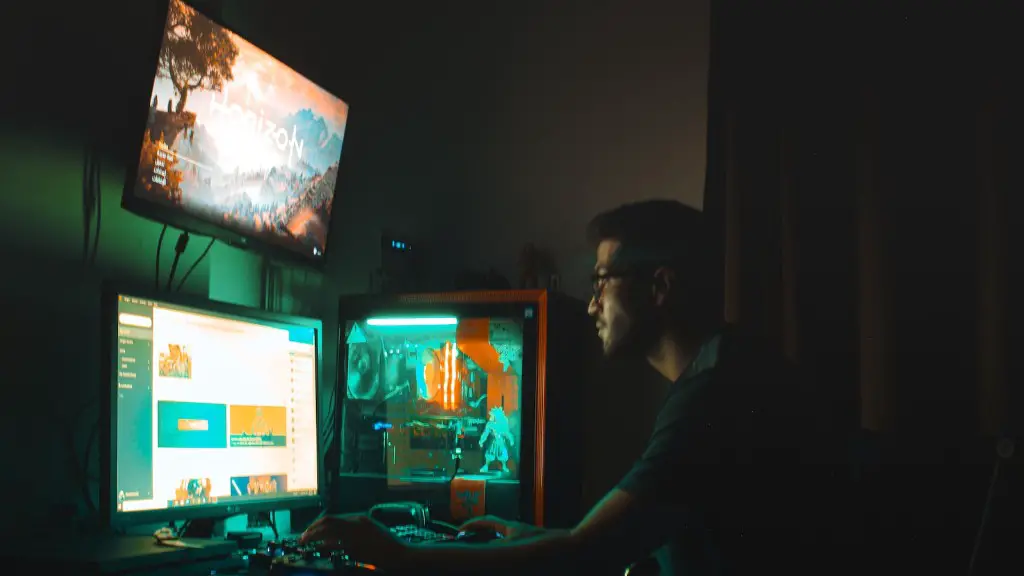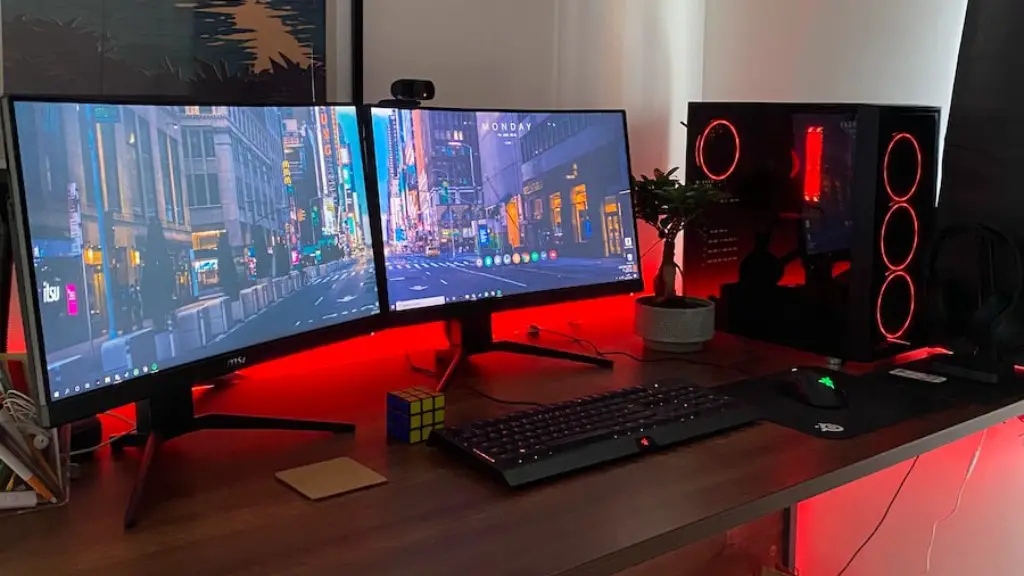The size of a gaming monitor is a key factor in achieving an ideal gaming experience. When it comes to gaming monitors, bigger isn’t always better. Even the best gamers will agree that the most ideal gaming monitor size is dependent on many factors including its purpose, the distance from the player and the size of the playing area. This article aims to discuss some of these factors in order to better understand what the ideal gaming monitor size should be.
Distance is a big factor when it comes to choosing the right size monitor for gaming. To ensure the clearest, easiest on the eyes viewing experience, the ideal distance from the monitor should be between 16 and 24 inches. Anything less than 16 inches could strain the eyes and anything more could cause discomfort. This distance guideline can also be used to calculate the ideal gaming monitor size. The resolution of the monitor should be considered when determining the size. Resolution is a measure of the clarity of an image, which means that higher resolution leads to a clearer image. Generally, high resolutions require a larger monitor for the full viewing experience.
Another factor to consider when determining the right gaming monitor size is the size of the playing area. The size of the monitor needs to be proportionate to the size of the playing area, otherwise it will be too big or too small. For example, if the playing area is too small, a bigger monitor won’t be as immersive as a smaller one. On the other hand, if the playing area is bigger, a bigger monitor could better enhance the gaming experience. Furthermore, it’s important to find the right balance between a monitor’s size and its resolution as larger monitors are usually associated with higher resolutions.
When choosing a gaming monitor size, one should also consider the monitor’s purpose. If a monitor is used for gaming primarily, then the size shouldn’t be too big or small. On the other hand, if a monitor is used for both gaming and watching movies, then the size should be bigger to accommodate the larger screen. It’s also worth considering monitors that feature multiple panels or even curved screens, as these can provide a more immersive gaming experience.
No matter what the primary purpose of a gaming monitor is, there is no doubt that the size of the monitor is an important factor. There are many things to consider when choosing the right size, such as the distance from the viewer and the playing area, as well as the monitor’s resolution and purpose. With that said, the ideal gaming monitor size should be determined based on the specific needs and preferences of the player.
Purpose of Gamers Monitor
The purpose of a gaming monitor is an important factor to consider when determining the ideal gaming monitor size. Gamers typically have different needs when it comes to choosing a gaming monitor and the type of game being played will determine the size and resolution of the monitor needed. For example, if a player is playing first-person shooter games, a bigger monitor would be better as it allows for more detail to be seen, whereas for strategy and rhythm games, a smaller monitor might be more suitable.
Additionally, the refresh rate of the monitor should also be taken into consideration. Refresh rate refers to how often the image is updated on the screen and this is something that can have a major impact on the gaming experience. Monitors with higher refresh rates usually provide smoother and more responsive visuals, while monitors with lower refresh rates may result in lag or stutter. As such, it’s important to get the right monitor with the right refresh rate in order to optimize the gaming experience.
Furthermore, it’s worth noting that some gaming monitors also come with certain features such as eye-tracking technology, adaptive sync and HDR. Adaptive sync, for instance, eliminates stutter and eliminates screen tearing for smoother visuals. Similarly, eye-tracking technology provides more intuitive and immersive gaming experiences by allowing games to track the player’s eye movements. HDR also enhances the visuals, allowing for more vivid and lifelike images on-screen.
When it comes to finding the ideal gaming monitor size, it all depends on the needs and preferences of the player. The key is to find the right balance between screen size, resolution, refresh rate and the other features mentioned above. Once this balance is found, the right gaming monitor size can be determined.
Distance from the Monitor
The distance from the monitor is an important factor to consider when choosing the right gaming monitor size. This is because the farther away a player is from the monitor, the bigger the monitor should be. This is due to the fact that sitting a certain distance away can cause the eyes to strain if the monitor is too small. The ideal distance from the monitor for gaming is between 16 and 24 inches, which should allow for a comfortable and clear viewing experience. Beyond these limits, the image may start to appear blurry or distorted.
Moreover, the size of the monitor also affects its resolution. Generally, larger monitors tend to have higher resolutions as this allows for greater detail and a clearer image. For example, a 24-inch monitor with a resolution of 1080p will offer a sharper and more detailed image than a 24-inch monitor with a resolution of 720p. As such, gamers should ensure that their monitor has the right resolution for their distance and viewing needs.
Furthermore, it’s important to note that monitors with higher refresh rates can also be beneficial when playing games. Refresh rate is a measure of how often an image is updated on the screen and monitors with higher refresh rates usually provide smoother and more responsive visuals. Therefore, it’s important to look for monitors with higher refresh rates if one wishes to experience optimal performance when gaming.
Overall, the distance from the monitor should be taken into account when choosing the right gaming monitor size as this can affect the clarity and detail of the image as well as the performance of the monitor. Therefore, gamers should ensure that they choose the right size monitor for their distance and viewing needs in order to get the most out of their gaming experience.
Size of the Playing Area
It is important to take into account the size of the playing area when determining the right gaming monitor size. The size of the monitor should be proportionate to the size of the playing area, otherwise it will be either too big or too small to fully enjoy the gaming experience. A larger playing area can be best suited for larger monitors as this will allow for a more immersive experience. On the other hand, a smaller playing area would be better suited for smaller monitors as this can provide a focused and better-defined gaming experience.
Moreover, gamers should also consider the pixel density of their monitor when determining the size of their gaming monitor. Pixel density is a measure of how many pixels are contained in a given area and the higher the pixel density, the more detailed and clearer the image will be. Therefore, if a monitor has a higher pixel density and is larger, it will likely offer a more immersive gaming experience. On the other hand, a monitor with a lower pixel density may not offer the same level of detail and clarity as one with a higher pixel density.
In addition, monitors that have curved screens can also be beneficial when choosing the right gaming monitor size. This is because curved screens are designed to provide a more immersive and immersive gaming experience. Curved screens also offer wider viewing angles, which can further enhance the gaming experience and make it easier to spot other players or hazards. Therefore, gamers should take into account the size of the playing area, the pixel density and the type of monitor before deciding on the ideal gaming monitor size.
Monitor Resolution & Refresh Rate
It is also important to consider the monitor’s resolution and refresh rate when choosing the ideal gaming monitor size. The resolution of a monitor is a measure of the clarity of an image and higher resolution monitors usually require larger monitors for the full viewing experience. Similarly, gaming monitors with high refresh rates can offer smoother and more responsive visuals, while monitors with lower refresh rates may result in lag or stuttering, so gamers should look for monitors with higher refresh rates to experience optimal performance when gaming.
Moreover, monitors with certain features such as adaptive sync, HDR and eye-tracking technology, can also be beneficial. For instance, adaptive sync eliminates screen tearing and stuttering, while HDR enhances the visuals, allowing for more vivid and lifelike images on-screen. Furthermore, eye-tracking technology allows games to track the player’s eye movements, providing a more intuitive and immersive gaming experience.
Overall, the resolution, refresh rate, and other features of the monitor should all be taken into account when determining the ideal gaming monitor size. These factors can all affect the gaming experience and should be considered carefully when making a decision on the best size of monitor for gaming.
Types of Gamers Monitors
Finally, it is important to consider the different types of monitors available when choosing the ideal gaming monitor size. Monitors vary in size and features, so gamers should take the time to research the different types available and decide which one is best for their gaming needs. Monitors with higher resolutions, bigger screens, or additional features such as HDR, adaptive sync, and eye-tracking technology, may all be beneficial and should be considered when deciding on the right gaming monitor size.
For instance, curved monitors may provide a more immersive and immersive gaming experience, while ultra-wide monitors can give gamers wider viewing angles. Gamers may also want to consider gaming laptop monitors which are typically smaller and not as full-featured, but can still offer a great gaming experience. Finally, monitors with multiple panels can be beneficial for users that need a lot of screen real estate, as these monitors can provide multiple displays with a single setup.
In conclusion, when it comes to finding the ideal gaming monitor size, there are many things to consider. Gamers must take into account the distance from the monitor, the size of the playing area, the resolution, the refresh rate, and other features such as adaptive sync, HDR, and eye-tracking technology. It’s also important to consider the different types of monitors available and make sure to choose the right one for their gaming needs. With all this in mind, gamers should be able to find the perfect gaming monitor size for their needs.



